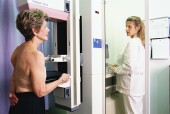
THURSDAY, Sept. 13 (HealthDay News) — For women between the ages of 50 and 70, the benefits of getting a mammogram every two years outweigh the potential harms, a new European study indicates.
“Breast screening in ages 50 to 69 confers a large reduction in risk of dying of breast cancer,” said study leader Stephen Duffy, a professor of cancer screening at Queen Mary, University of London.
The benefit in terms of lives saved, he said, “is considerably greater than the harm in terms of overdiagnosis.” Overdiagnosed cancers are those found during screening that would never have given rise to symptoms during a woman’s lifetime and would not have been found without the mammogram.
For every 1,000 women aged 50 to 69 screened every two years, Duffy found, an estimated seven to nine lives were saved.
The new study is published in the Sept. 13 issue of The Journal of Medical Screening.
The findings probably apply to U.S. women as well, said Dr. Virginia Moyer, chair of the U.S. Preventive Services Task Force.
Besides the lives saved, Duffy’s team also looked at the downsides of screening. For every 1,000 women, they found that four were overdiagnosed. In addition, an estimated 170 of the 1,000 women would have at least one recall followed by a noninvasive test that turned up negative. Another 30 would have at least one recall followed by an invasive procedure that turned up negative.
For the new report, researchers from the European Screening Network, with members from nine European countries where the results of screening programs have been assessed, reviewed the benefit estimates in published studies.
A second group of researchers, the European Network for Indicators on Cancer, reviewed 26 different screening programs in 18 countries between 2001 and 2007 that included 12 million women.
The researchers considered the harms and benefits from the time the women were 50 until they were 79.
The best intervals for mammography screening, and the question of when to begin, is a topic of ongoing debate. In 2009, the U.S. Preventive Services Task Force (USPSTF), which makes recommendations about preventive medical services, ignited a firestorm of debate when it recommended against routine screening for women 40 to 49; instead suggesting that women discuss it with their doctor and decide on an individual basis.
Women aged 50 to 74 are advised by the task force to have a mammogram every two years.
Other U.S.-based organizations, including the American Cancer Society, continue to recommend that women begin routine annual mammography screening at age 40.
The findings of a benefit for women 50 and older are in line with the task force recommendations, said Moyer, who is also chief of academic medicine at Texas Children’s Hospital, in Houston.
“The data collected here confirm the current USPSTF recommendation for women 50 to 69,” she said.
The estimates about overdiagnosis can vary widely, she said, because the data gathered by the European researchers are from observational rather than experimental studies. Even so, she said, ”these findings confirm that while there is harm [overdiagnosis, which means unnecessary treatment and anxiety], the benefits outweigh the harms in women 50 to 69, when mammography is performed every two years.”
Worldwide, breast cancer is the most frequent cancer affecting women. About 1.4 million women worldwide were diagnosed with it in 2008.
More information
To learn more about mammograms, visit the U.S. National Cancer Institute.

